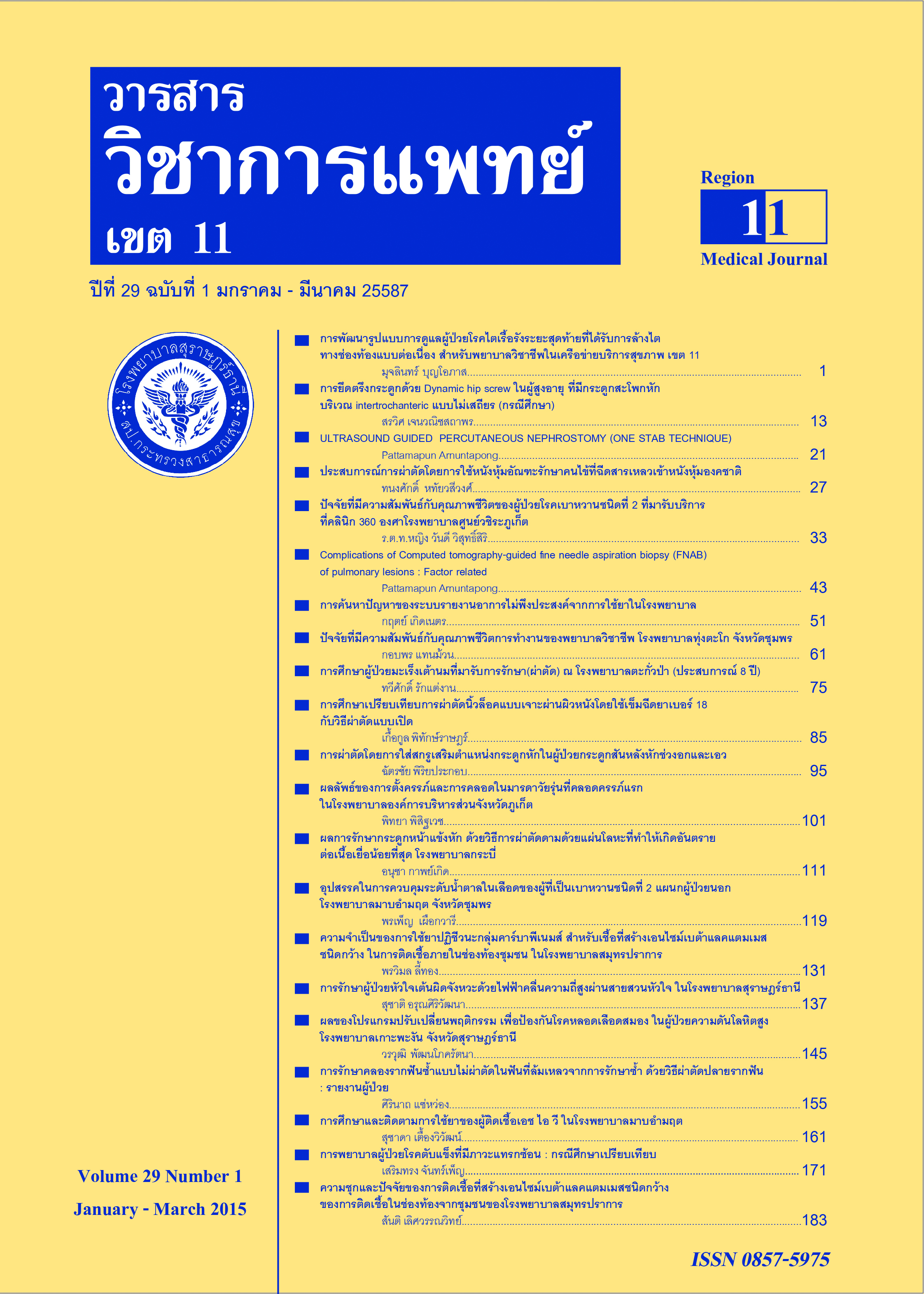Factors Relating to the Quality of Life for: Type II Diabetes Mellitus Patients at the 360 Degree Clinic, Vachira Phuket Hospital
Keywords:
quality of life, diabetes mellitus type IIAbstract
Diabetes Mellitus is a chronic illness (disease) that has never been cured. Patients must be proactive in their personal care and life-style, by controlling variables such as: quality and quantity of food, medications, rest and exercise. The diabetic patient has to make appropriate life-style choices, otherwise complications to the kidneys, eyes or feet can occur, in addition to other ailments. These factors often determine the individual patient’s quality of life.
This research aims to explore these factors, in patients with Diabetes Mellitus Type II. The study included 245 patients with Diabetes Mellitus Type II, all having suffered from the disease since one year. In January 2015, these 245 patients received their treatment at the 360 Degree Clinic, located in Vachira Public Hospital, Phuket.
Method : The WHOQOL-BREF instrument is comprised of 26 items, which measured the following broad Domains: physical health, psychological health, social relationships and environment. The Questionnaires were collected, generating various critical analyses, consisting of statistical average, standard deviation, T-test and ANOVA.
Findings : The findings indicated that 63.67 percent of the Diabetes Mellitus Type II patients were rated at a good level, while 16.32 percent of participants were rated at medium and best level. Integral health factors concomitant to the patient’s quality of life were as follows: the appearance of signs and symptoms, and crippling complications caused by the disease (Diabetes). These factors could be mitigated, or even eliminated, if the patient’s needs and care were directed through an appropriate clinic.
Moreover, individual factors relating to a patient’s quality of life include their occupation, financial status, and family situation. Therefore, close attention should be paid to all Diabetes Mellitus Type II patients in treatment, keeping in mind the inherently unique needs of each individual patient.
References
2553; 41(39): 622 - 24.
2. เทพ หิมะทองคำ. ความรู้เรื่องโรคเบาหวานฉบับสมบูรณ์. กรุงเทพมหานคร: จูนพับลิชชิ่ง (7), 2548.
3. สมาคมโรคเบาหวานแห่งประเทศไทย. แนวทางเวชปฏิบัติสำหรับโรคเบาหวาน พ.ศ. 2554. กรุงเทพมหานคร:บริษัทศรีเมืองการพิมพ์จำกัด, 2554.
4. Daniel WW. Biostatistics : Basic concepts and Methodology for the Health Sciences 9th ed. New Jersey: John Wiley & Sons Inc.; 2010.
5. สุชาติ ประสิทธิ์รัฐสินธุ์. เทคนิคการวิเคราะห์ตัวแปรหลายตัวสำหรับการวิจัยทางสังคมศาสตร์และพฤติกรรมศาสตร์ พิมพ์ครั้งที่ 5. กรุงเทพมหานคร: หจก.สามลดา; 2548.
6. ศลาฆนันท์ หงส์สวัสดิ์. คุณภาพชีวิตที่สูญเสียไปของผู้ป่วยโรคเบาหวานชนิดไม่พึ่งอินซูลิน. วิทยานิพนธ์ปริญญาวิทยาศาสตรมหาบัณฑิต สาขาบริหารสาธารณสุข บัณฑิตวิทยาลัย มหาวิทยาลัยมหิดล,2551.
7. เสกสรร หีบแก้ว. คุณภาพชีวิตของผู้ป่วยเบาหวานชนิดที่ 2 อำเภอกุฉินารายณ์ จังหวัดกาฬสินธุ์. วารสารวิจัยและพัฒนาระบบสุขภาพ. หน้า 22 – 36.
8. พงศ์อมร บุนนาคและคณะ. คุณภาพชีวิตและการควบคุมระดับน้ำตาลในเลือดของผู้ป่วยเบาหวานที่มาตรวจรักษาที่หน่วยตรวจโรคผู้ป่วยนอกอายุรกรรม โรงพยาบาลรามาธิบดี. รามาธิบดีเวชสาร 2548; 28 ;4:227 – 235.
9. ศิรินทิพย์ โกนสันเทียะ. คุณภาพชีวิตผู้ป่วยเบาหวานโรงพยาบาลเฉลิมพระเกียรติสมเด็จย่า 100 ปี เมืองยางอำเภอเมืองยาง จังหวัดนครราชสีมา. วารสารวิทยาลัย
พยาบาลบรมราชชนนี นครราชสีมา 17; 1 มกราคม –มิถุนายน 2554: 31 – 44.
10. จิณณพัฒ ธีรอภิศักดิ์กุลและคณะ. คุณภาพชีวิตและปัจจัยทางด้านจิตสังคมของผู้ป่วยเบาหวานชนิดไม่พึ่งอินซูลิน ในโรงพยาบาลสมเด็จพระพุทธเลิศหล้า จังหวัดสมุทรสงคราม.วารสารสมาคมจิตแพทย์แห่งประเทศไทย 2551 54; 2: 185 - 196.
11. เอกพล วิรัตน์. ปัจจัยที่มีผลต่อคุณภาพชีวิตผู้ป่วยเบาหวานชนิดที่ 2 ในเขตตำบลท่าขอนยาง อำเภอกันทรวิชัย จังหวัดมหาสารคาม. ปริญญาเภสัชศาสตร์บัณฑิต. มหาวิทยาลัยมหาสารคาม. 2553.






